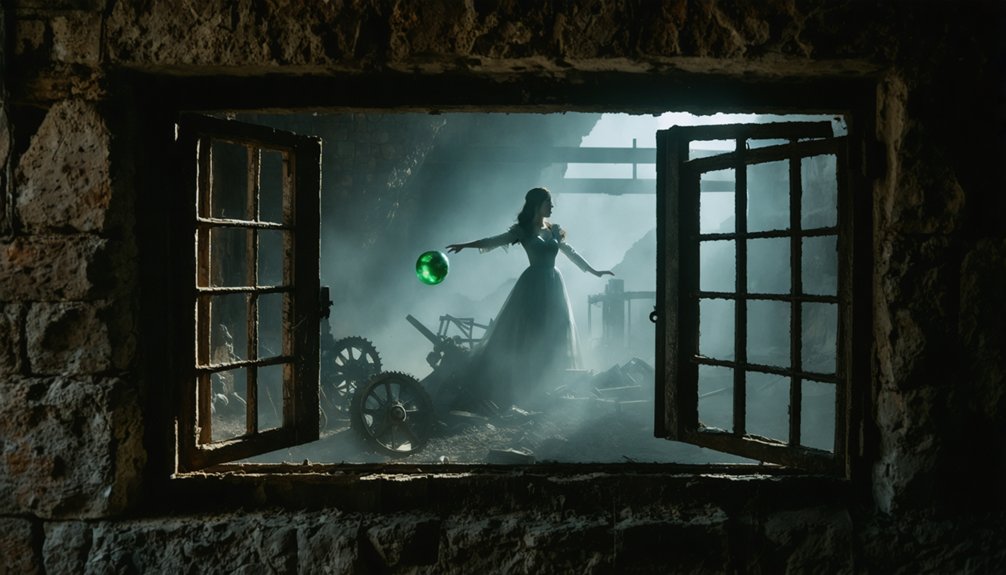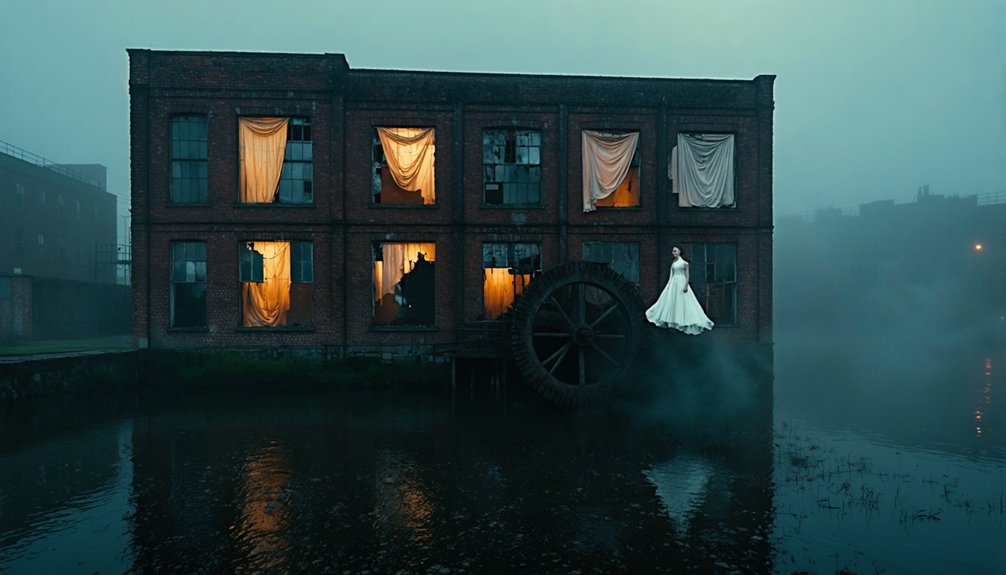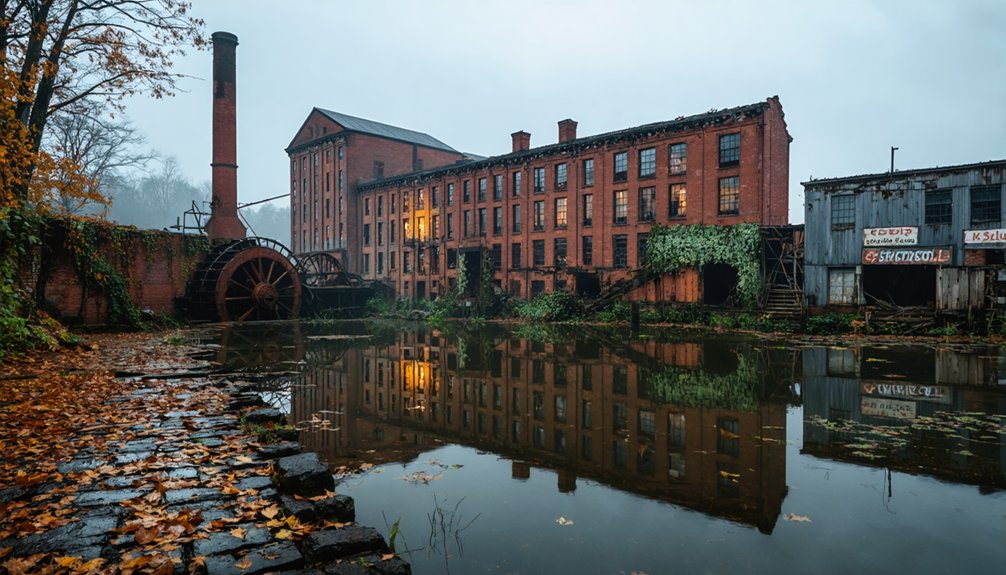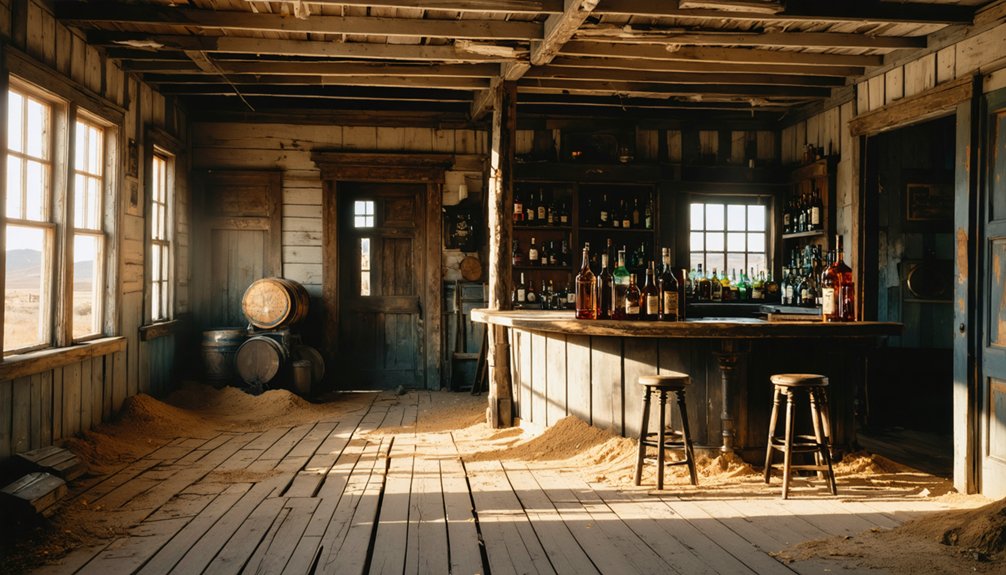America’s abandoned mill towns harbor terrifying spirits from industrial-era tragedies. You’ll encounter vengeful widows seeking justice, child laborers who died tragically young, and phantom foremen eternally supervising empty operations. These hauntings manifest through unexplained phenomena—machinery operating without power, footsteps in vacant corridors, and shadowy figures in period attire. Each spirit tells a unique story of injustice, representing the human cost behind America’s industrial prosperity. Their supernatural echoes await beyond the decaying facades.
Key Takeaways
- The Widow’s vengeful spirit haunts abandoned mill towns, manifesting through footsteps, cold spots, and apparitions in early 1900s attire.
- Child laborer ghosts operate phantom looms throughout Southern textile factories, representing the quarter of mill workers under age 16 circa 1900.
- Restless accident victims cause unexplained machinery activations, temperature drops, and spectral workers appearing on anniversary dates of industrial tragedies.
- The Phantom Foreman continues supervising abandoned gold mining operations, creating unexplained footsteps and shadowy figures during night hours.
- Modern explorers vanish in deteriorating ghost mill towns like Pine Point, Dudleytown, and Centralia, where structural dangers compound paranormal threats.
The Vengeful Souls of Miller’s Mine: A Homestead Massacre’s Aftermath
While the Homestead Strike of 1892 remains one of America’s most notorious labor conflicts, the tragedy at Miller’s Mine in Teton, Idaho represents an equally disturbing chapter in mill town history.
The mine gained infamy following a series of mysterious disappearances among its workers. As suspicion mounted, surviving miners concluded that one of their own was eliminating colleagues to monopolize undiscovered gold deposits.
Paranoia turned colleague against colleague as miners vanished, each death feeding suspicions of treachery for gold’s sake.
Their response was horrific—they massacred the entire mining party, including women and children, then burned the bodies above the mine site. This gruesome act mirrors the chaos seen when Pinkerton agents attempted to land at Homestead mill, resulting in casualties on both sides.
Similar to Paydown’s mills that were built because of their access to valuable water resources, Miller’s Mine developed around natural resources that promised wealth to those who controlled them.
Ironically, the burial ground later became a dig site believed to contain rich gold deposits.
Today, you’ll find Miller’s Mine among Idaho’s most haunted locations, where vengeful spirits of the murdered reportedly manifest as apparitions and unexplained sounds—eternal witnesses to the brutal extremes humans will reach for wealth.
Child Spirits in the Cotton Mills: Echoes of Young Workers
Among the most disturbing apparitions haunting America’s historic mill towns are the spirits of child laborers who perished within the cotton mills‘ unforgiving walls.
You’ll find these ghostly children most prevalent in Southern textile factories, where by 1900, a quarter of all mill workers were under 16—many younger than 12.
These young spirits manifest in facilities where children once endured 12-hour workdays in sweltering, poorly ventilated rooms amidst dangerous machinery. By 1820, children under 15 constituted nearly 50% in cotton mills, highlighting how deeply entrenched child labor was in textile manufacturing.
Despite laws passed in the early 1900s limiting workweeks and prohibiting night shifts for those under 16, enforcement remained weak until the Fair Labor Standards Act of 1938.
The haunting legacies of these young victims serve as powerful reminders of industrial exploitation.
Their spectral forms—often seen operating phantom looms or wandering mill floors—preserve the tragic history of child labor through local folklore and oral traditions. Many visitors have reported seeing ghostly figures that appear and vanish suddenly, much like Thomas at the old mill.
The Phantom Foreman of Bodie: Doomed to Oversee Empty Mines
Deep in the ghostly remains of Bodie, California, a spectral figure known as the Phantom Foreman still haunts the abandoned gold mining operations.
As you wander through this perfectly preserved ghost town, you might encounter this legendary spirit eternally overseeing the mills that once processed millions in gold and silver from 1876 to 1941.
- Park rangers report phantom sightings near old mining machinery during night patrols
- Visitors describe hearing unexplained footsteps and seeing shadowy figures in the mills
- Mining folklore connects the Foreman’s presence to Bodie’s violent, lawless past
- The spirit represents miners who couldn’t leave their work behind, even in death
The Phantom Foreman embodies Bodie’s tragic mining heritage, forever trapped in arrested decay alongside the town that once boasted 8,000 residents before becoming abandoned by 1915. Many investigators attribute these phenomena to residual hauntings where traumatic energy from the past becomes imprinted on the environment.
The Widow’s Wrath at Henry River Mill: Love and Betrayal
You’ll encounter the vengeful spirit of the Widow’s Wrath at Henry River Mill Village, where she manifests as a bride betrayed by mill politics and personal treachery.
Her spectral form haunts the abandoned looms during moonlit nights, creating unexplained sounds of machinery long silent and appearing as a woman in mourning dress near workers’ cottages.
The lace-maker’s broken promise, central to her tragic story, serves as both warning and cultural touchstone in this Appalachian community where the boundaries between industrial history and supernatural folklore have blurred through generations of oral tradition. The story shares similarities with Willington Mill, which became known as the most haunted house in England during the nineteenth century. Many visitors come to experience these paranormal encounters during the special paranormal tours offered at the historic site.
Betrayed Bride’s Spectral Vengeance
The haunting legend of the Betrayed Bride at Henry River Mill emerges as perhaps the most chilling manifestation of unresolved emotional energy in this abandoned industrial landscape.
You’ll encounter a narrative deeply woven into the mill’s troubled history since its 1905 founding, where spectral justice manifests through unexplained phenomena documented in local testimonies.
- Shadowy figures appear near the burned mill ruins, believed to represent the bride seeking vengeance.
- Unexplained footsteps and cold spots correlate with locations tied to romantic betrayal stories.
- Investigators have collected diaries recounting emotional hauntings dating to the mill’s operational years.
- Nightly disturbances intensify during anniversaries of the mill’s 1977 fire.
This archetypal ghost story transcends mere superstition, symbolizing broader themes of injustice within early textile communities and unfinished emotional business manifesting through paranormal activity. Visitors initially drawn to the site because of its fame as District 12 in The Hunger Games often report sensing an otherworldly presence in the remaining houses. The cramped living conditions where over 300 people resided in just 35 homes likely contributed to the intense emotional energy that paranormal enthusiasts claim to detect today.
Moonlit Loom Hauntings
Among the spectral inhabitants of Henry River Mill, the Widow’s Wrath manifests as a particularly haunting presence beneath the glow of moonlight.
You’ll find her ethereal form near the abandoned company store or worker homes, where her story of love and betrayal echoes through the century-old ruins.
Visitors report moonlit apparitions accompanied by sobbing and spectral whispers, particularly on anniversaries of mill tragedies.
Her manifestations often coincide with paranormal anomalies near water sources that once powered the textile operations.
Unlike other mill ghosts, the Widow represents protective vengeance—a response to industrial-era injustices that befell mill families between 1905 and 1970.
Her haunting serves as both cautionary tale and historical record, embodying the emotional weight of those who suffered economic collapse in this now-preserved ghost town.
Lace-Maker’s Broken Promise
Beneath the crumbling infrastructure of Henry River Mill Village, tales of the Lace-Maker’s broken promise continue to resonate through abandoned corridors and empty worker cottages.
You’ll find that local folklore centers around a betrayed widow whose spectral love story transformed into haunting whispers after a mill supervisor’s unfaithfulness. Her profound grief manifested as supernatural disturbances that persist decades after the mill’s 1970 closure.
- Witnesses report unexplained footsteps and shadowy figures dressed in early 1900s textile worker attire.
- Cold spots and whispering sounds reminiscent of lamentations permeate the abandoned buildings.
- Doors slam without cause in the boarding house where the widow allegedly resided.
- Paranormal investigators cite historical diary entries that corroborate details of her tragic textile mill accident.
Bloodstained Machinery: The Restless Victims of Industrial Accidents
Throughout the history of America’s industrial revolution, machinery has transformed from symbols of progress into vessels for spectral phenomena, particularly when stained by the blood of workers who suffered fatal accidents.
You’ll find these haunted machinery tales serve as tragic reminders of an era before robust safety regulations.
When you visit abandoned mills, you might hear the ghostly whirring of looms or grinding of presses where workers once suffered entanglement deaths.
Maintenance logs often corroborate these paranormal claims, documenting unexplained mechanical activations and persistent malfunctions at accident sites.
In locations like Blackwood Mill, you can track the anniversary phenomenon where spectral workers continue their shifts.
These industrial accidents—crushings, falls, and chemical exposures—seemingly bind victims’ spirits to their fatal workstations, their presence manifesting through temperature drops and electronic disruptions.
The Whispering Walls of Rhyolite: Messages From the Beyond

When you stand amid the crumbling ruins of Rhyolite, Nevada, you’re likely to experience the infamous “whispering walls” phenomenon that has captivated paranormal enthusiasts for decades.
This abandoned boomtown, once thriving with 5,000 residents during the 1906-1907 gold rush, now harbors spectral messages from former inhabitants.
- The Bottle House, constructed from 50,000 glass bottles, remains one of the most actively haunted structures where whispers echo through empty corridors.
- Disembodied metallic clanging sounds near mine shafts mimic pickaxes striking rock—sounds with no visible source.
- Faint piano music drifts through the town despite no instruments remaining.
- Unnaturally warm air near mine entrances suggests residual energy lingering underground.
While skeptics attribute these phenomena to wind patterns and shifting structures, locals maintain these are communications from miners who perished in Rhyolite’s harsh conditions.
Midnight Shifts: Ghost Workers Who Never Clocked Out
The darkest hours at abandoned mills and factories across America’s rust belt often reveal a peculiar phenomenon that locals have documented for decades: the persistent presence of ghost workers who seemingly never clocked out from their final shifts.
At sites like the Republic Rubber Company in Youngstown and the Olivesburg plant in Ohio, phantom footsteps echo through empty corridors around midnight. These locations, where traumatic industrial accidents claimed lives, particularly foster ghostly apparitions in period work clothes.
The Cape Fear Meat Packing Plant exemplifies this pattern—its owner’s spirit reportedly lingers after his suicide.
These manifestations—cold spots, machinery sounds despite disconnected power, and moving shadows near elevator shafts—preserve the social memory of difficult labor conditions.
Communities retain these stories as living connections to their industrial heritage, marking workers whose devotion transcended mortality.
The Curse of Stolen Land: Native American Spirits Reclaiming Mining Towns

Beneath the weathered facades of America’s abandoned mining towns lies a darker historical narrative involving displaced Indigenous peoples whose spiritual connection to the land never truly severed.
As you explore these ghostly remnants, you’re walking on contested ground where ancestral guardians still maintain their vigilance.
- Apparitions of Native figures often appear at dusk near sites of cultural significance, warning trespassers of impending danger.
- Temperature drops and disembodied voices speaking Indigenous languages commonly precede manifestations of spiritual retribution.
- Jerome, Arizona residents report consistent encounters with protective spirits who seem to guard specific locations with unusual intensity.
- Mining accidents, equipment failures, and inexplicable illness have historically plagued those who disrespected sacred burial grounds.
These phenomena represent more than mere ghost stories—they embody ongoing resistance against historical injustice through supernatural means that transcend physical displacement.
The Old Mill Witch: Supernatural Guardian of Abandoned Factories
Across the shadowy remnants of America’s industrial past, legends of the Old Mill Witch have persisted for generations, creating a unique intersection between supernatural folklore and labor history.
You’ll find her story preserved by the William G. Pomeroy Foundation, documenting how this protective spirit with amber eyes and silver hair once provided healing remedies to struggling mill workers.
Unlike malevolent apparitions, this benevolent guardian continues her watchful presence along village streets near abandoned factory sites.
Eyewitnesses consistently report encountering her spectral form at night, describing sudden appearances followed by inexplicable vanishing. Many experience a profound sense of calm in her presence.
The Old Mill Witch symbolizes community resilience during industrial hardship, representing care in an era of limited medical access. Her enduring legend now drives tourism and preserves an important chapter of millworker history.
Vanishing Visitors: Modern Disappearances in Ghost Mill Towns

While the Old Mill Witch offers supernatural protection, modern ghost mill towns present a darker phenomenon: unexplained disappearances that continue to baffle investigators and locals alike.
These abandoned industrial sites harbor environmental hazards and possible paranormal activity that may explain why some visitors never return.
- Pine Point and Dudleytown report disappearing tourists who venture into deteriorating structures, their absences often remaining undocumented due to remote locations.
- Centralia’s underground coal fire creates toxic conditions where trespassers become disoriented, sometimes vanishing entirely.
- Structural collapses in unmaintained buildings trap explorers, particularly in Bodie’s decaying mining tunnels.
- Visitors to Kolmanskop describe ghostly encounters before seemingly vanishing into the surrounding desert, their cases complicated by sudden sandstorms and isolation.
Frequently Asked Questions
Can Paranormal Activity Increase During Certain Seasons in Mill Towns?
As autumn leaves fall, so do the veils between worlds. You’ll find seasonal spirits intensify during fall and winter months in mill town hauntings due to environmental factors, historical anniversaries, and increased community engagement.
Are Specific Tools or Objects More Likely to Retain Spiritual Energy?
You’ll find that metals, crystals, and personal artifacts demonstrate heightened spiritual resonance. Items with emotional connections or those used in rituals typically exhibit stronger energy retention capacities through prolonged interaction.
Why Do Some Spirits Interact With Technology While Others Avoid It?
In Waverly Hills Sanatorium, EVPs clearly capture voices while apparitions remain camera-shy. You’ll find spirits interact with technology based on their earthly familiarity, energy capacity, and intention for spirit communication, while others avoid technology interaction altogether.
What Paranormal Protection Methods Work Best in Abandoned Mining Settlements?
You’ll find spiritual cleansing with sage most effective in abandoned mining settlements. Combine this with protective crystals like black tourmaline and iron objects to create thorough barriers against lingering energetic imprints from tragic pasts.
Can Hauntings Transfer to Artifacts Removed From Mill Town Locations?
Where there’s smoke, there’s fire. You’ll find artifact energy can indeed transfer from mill towns, especially in objects with historical significance connected to traumatic events or containing piezoelectric materials.
References
- https://www.thehauntedmillinteton.com/millers-mine
- https://whyhorror.blog/2020/09/11/why-30-haunted-places/
- https://studyfinds.org/americas-ghost-towns/
- https://www.gothichorrorstories.com/real-ghost-stories/
- https://roadtrippers.com/magazine/henry-mill-river-hunger-games-district-12/
- https://www.scribd.com/document/667333822/Ghosts-and-Haunted-Places-Mysteries-Legends-And-Unexplained-Phenomena-PDFDrive
- https://www.youtube.com/watch?v=0Cxg-0Bc7Os
- https://en.wikipedia.org/wiki/List_of_reportedly_haunted_locations
- https://www.wgpfoundation.org/historic-markers/old-mill-witch/
- https://en.wikipedia.org/wiki/List_of_reportedly_haunted_locations_in_the_United_States



